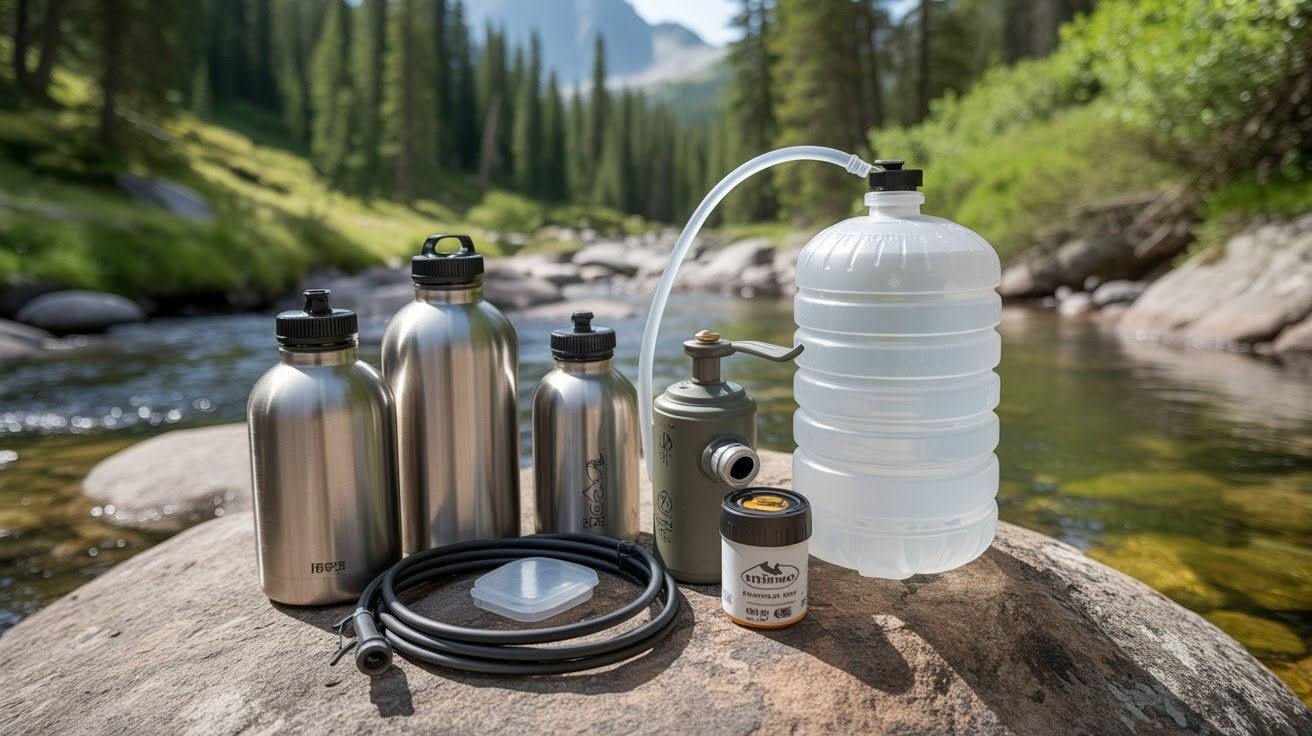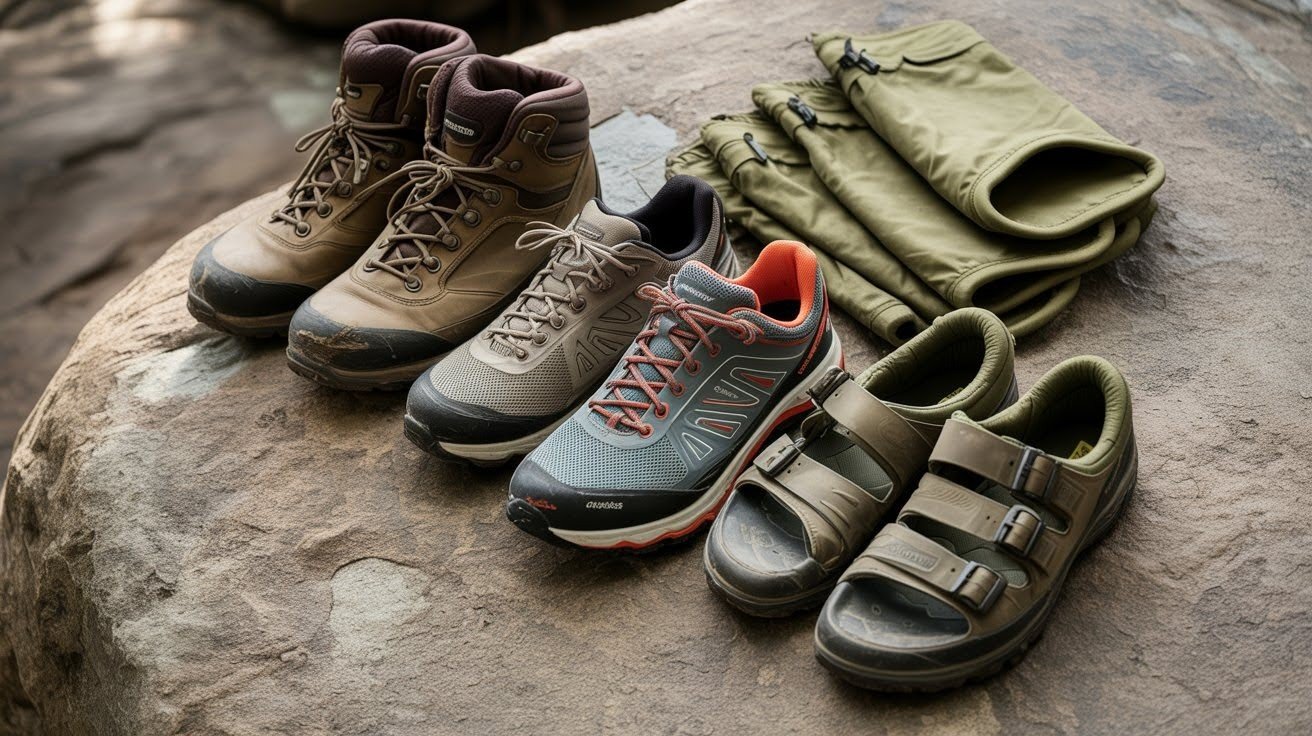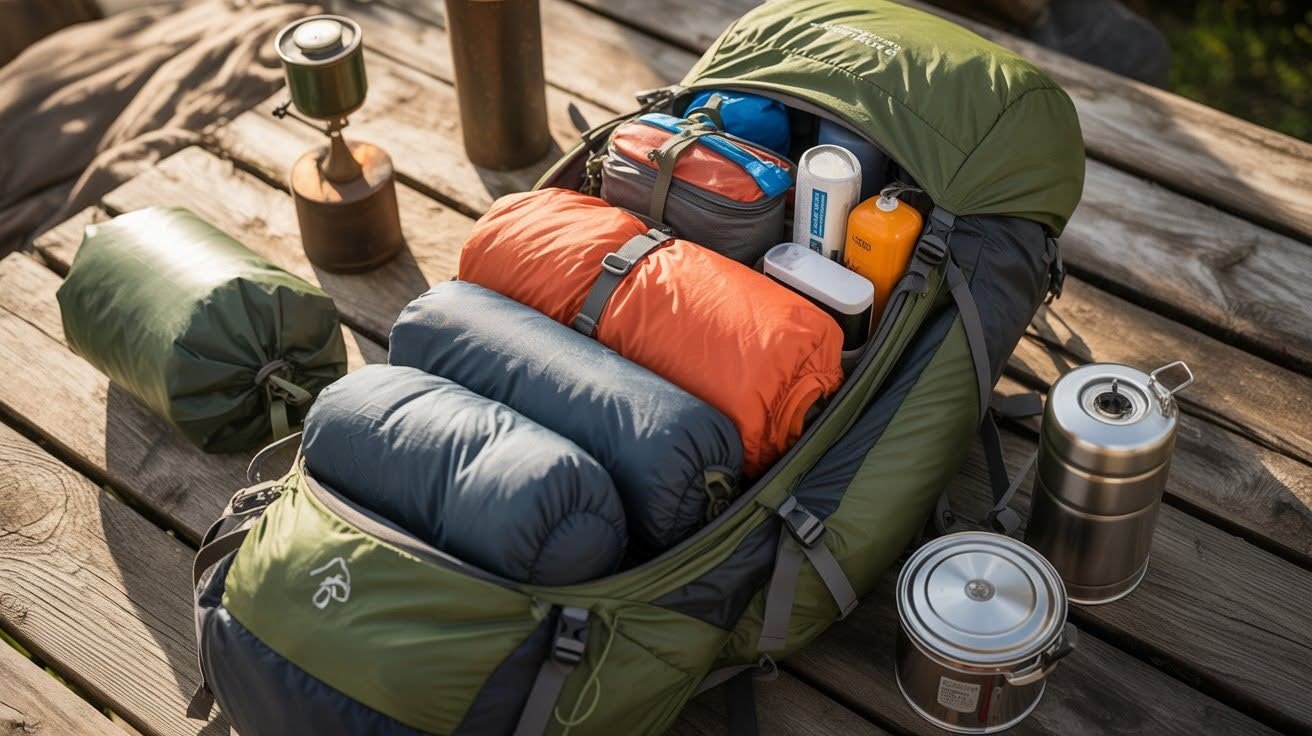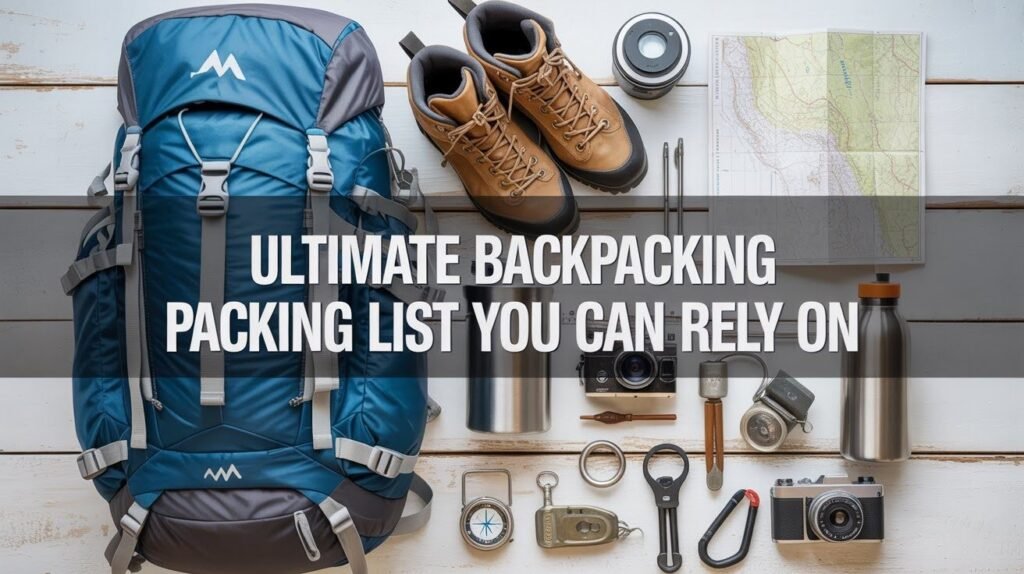Have you ever arrived at a trailhead only to realize you forgot something important? Proper preparation can make or break your backpacking experience.
A well-organized backpacking packing list helps you stay comfortable and safe in the wilderness. This guide will walk you through everything you need for a successful multi-day trip.
We’ve broken down our backpacking packing list into clear categories that cover all the basics. From shelter to clothing, we’ll make sure you don’t leave anything behind.
This list focuses on three-season backpacking trips, which means spring, summer, and fall conditions. With the right gear packed in your bag, you’ll be ready to handle whatever nature throws your way.
Essential Backpacking Gear You Need to Bring
Getting your core gear right is the foundation of any successful trip. These items will keep you protected, fed, and comfortable on the trail.
1. Backpack and Pack Accessories

Your backpack is your home away from home, so choose wisely. For multi-day trips, look for a pack between 50 and 80 liters, depending on how long you’ll be out and how much gear you need to carry.
Don’t forget to protect your belongings from rain and moisture. A rain cover or waterproof liner will keep your gear dry even in heavy downpours. Compression sacks help organize your items and save valuable space inside your pack.
2. Shelter System

A reliable tent with a rainfly, poles, and stakes is your first line of defense against the elements. Make sure all components are included and in good condition before you hit the trail.
Some backpackers prefer alternative shelter options like hammocks or tarps, especially on warm-weather trips. A groundsheet placed under your tent adds extra protection from moisture, rocks, and rough terrain that could damage your tent floor.
3. Sleep Setup

Quality sleep is crucial for enjoying your backpacking trip and staying energized for the next day. Your sleeping bag should have a comfort rating between 15°F and 30°F for most three-season conditions.
A sleeping pad with an R value of 2 or higher provides insulation from the cold ground and cushioning for comfort. Many backpackers also bring a camping pillow for better sleep, though this item is optional depending on your personal preference and pack weight concerns.
4. Cooking Equipment and Food Storage

A lightweight backpacking stove and fuel allow you to prepare hot meals and drinks on the trail. Choose a cookset that includes a pot sized right for your group, plus basic utensils for cooking and eating.
Bring a mug for hot beverages and proper eating supplies for every meal. A bear canister or approved food storage system is required in many wilderness areas to protect wildlife and your food supply. Pack biodegradable soap and cleaning supplies to wash your dishes and maintain good hygiene at camp.
5. Water Management

Staying hydrated is critical in the backcountry, so plan your water-carrying system carefully. Bring water bottles or a hydration reservoir that holds enough liquid to get you between reliable water sources.
A water filter or purification system removes harmful bacteria and parasites from natural water sources. Keep backup chemical purification tablets in your kit for emergencies. A collapsible water container is useful at camp for cooking and cleaning without multiple trips to the water source.
6. Clothing Layers

The layering system is key to staying comfortable in changing weather and activity levels. Start with moisture-wicking base layers and underwear that pull sweat away from your skin.
Quick-drying pants or shorts work well for hiking, while a long-sleeve shirt provides sun protection on exposed trails. An insulating midlayer like fleece or a light puffy jacket traps warmth when temperatures drop. Pack a packable down jacket for cold mornings and evenings at camp.
A rain jacket is necessary, and rain pants are a good addition if you expect wet conditions. Bring a warm beanie for chilly nights and a sun hat for daytime protection. Sunglasses shield your eyes from harmful UV rays and glare. Always pack multiple pairs of synthetic or wool socks, as your feet take a beating on the trail.
7. Footwear Options

Your choice of footwear depends on the terrain, your pack weight, and personal preference. Hiking boots offer ankle support and durability for rough trails, while hiking shoes and trail runners provide lighter weight and faster drying times.
Consider the type of ground you’ll cover and how heavy your loaded pack will be when making this decision. Many backpackers bring optional camp shoes or sandals to give their feet a break after a long day. Gaiters keep debris, snow, and water out of your boots in specific trail conditions.
Important Safety and Personal Items

Safety gear can save your life in an emergency. These items might seem small, but they make a huge difference when things don’t go as planned.
- Navigation tools, including a map, compass, and GPS device, help you stay on course.
- First aid kit stocked with supplies for common injuries, plus any prescription medications you need
- Headlamp with extra batteries or a power bank so you can see in the dark
- Emergency supplies like a whistle, fire starter, and waterproof matches for signaling and warmth
- Knife or multi-tool for repairs and food preparation
- Repair kit with duct tape and sleeping pad patches for fixing gear problems
- Personal hygiene items, including a trowel, toilet paper, and hand sanitizer
- Sun protection with sunscreen and SPF lip balm to prevent burns
- Insect repellent to keep bugs away
- Menstrual products, if needed, for your trip timing
- Optional satellite messenger or personal locator beacon for remote areas
These safety items take up minimal space but provide maximum peace of mind. Don’t skip them just to save weight, as they could be the difference between a minor inconvenience and a serious problem.
Tips for Packing Your Backpack Efficiently

How you pack your backpack affects your comfort and balance on the trail. Smart packing makes everything easier.
- Pack heavy items close to your back and centered for better weight distribution.
- Keep frequently used items easily accessible in top pockets or outer compartments.
- Store your sleeping bag at the bottom since you only need it at camp
- Use compression sacks to save space and keep similar items together
- Pack rain gear in an outer pocket for quick access when the weather changes
- Bring an extra day’s supply of food for emergencies or delays
- Test your pack weight before the trip by taking a short practice hike
- Remember to balance comfort and weight for the best experience
Good packing technique reduces strain on your body and makes finding things much simpler. Take time to organize your gear thoughtfully before leaving home.
Conclusion
A complete backpacking packing list is your key to a successful and enjoyable trip. By covering all the categories we’ve discussed, you’ll be prepared for the challenges and rewards of the backcountry.
Feel free to customize this list based on your specific trip conditions and personal needs. Every trail and season is different, so adjust your gear accordingly.
Always check weather forecasts and current trail conditions before you leave. This information helps you pack the right clothing and equipment for what you’ll actually face out there.
With your gear organized and your backpacking packing list checked twice, you’re ready to create amazing memories in the great outdoors. Get out there and enjoy the trails!
Frequently Asked Questions
How Much Should My Loaded Backpack Weigh?
A good target is 20% of your body weight or less for comfortable hiking. Beginners often start heavier and reduce pack weight as they gain experience. Focus on essential items and look for lightweight gear options to decrease the load on your back and joints.
Can I Use a Smaller Pack for an Overnight Trip?
Yes, a 30 to 50 liter pack works well for overnight trips with minimal gear. You’ll need less food, water, and clothing than longer trips require. This smaller size is easier to carry and still fits all your necessary equipment for a single night out.
What’s the Difference Between a Sleeping Bag and a Quilt?
Sleeping bags fully surround you with insulation, while quilts cover only your top and sides. Quilts are lighter and more versatile but require proper use to avoid cold spots. Both options work well, so choose based on your sleeping style, weight preferences, and temperature needs.
Do I Really Need to Bring a Map and Compass?
Absolutely yes, even if you have a GPS device or smartphone. Electronic devices can fail due to dead batteries, damage, or a lack of signal. Paper maps and compasses never run out of power and provide reliable backup navigation. Learn how to use them before your trip.
How Do I Choose Between Canister and Liquid Fuel Stoves?
Canister stoves are simpler to use and cleaner burning, making them great for beginners. Liquid fuel stoves work better in cold weather and at high altitudes. Consider your trip conditions, ease of use preferences, and fuel availability when making this decision for your backpacking packing list.

